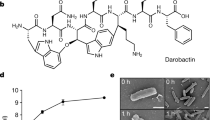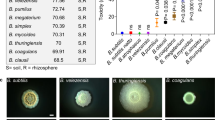Abstract
THE adaptation of micro-organisms1 and insects2 to antimetabolites used in the control of the latter is an important contemporary problem. It has been conjectured that a possible mechanism for such adaptation might be : formation of new metabolic pathways, creation of inhibitors or enzymes neutralizing antimetabolites, or modification of the permeability of structures sensitive towards antimetabolites3,4. These mechanisms, in so far as they concern penicillin, would involve an induced biosynthesis of penicillinase which suppresses the antimetabolic activity of penicillin, an autotrophic biosynthesis of amino-acids the assimilation of which by the milieu is inhibited by penicillin5, or a modification of bacterial surface structure6. All or any of these mechanisms might make the antimetabolite innocuous to the living cell.
This is a preview of subscription content, access via your institution
Access options
Subscribe to this journal
Receive 51 print issues and online access
$199.00 per year
only $3.90 per issue
Buy this article
- Purchase on Springer Link
- Instant access to full article PDF
Prices may be subject to local taxes which are calculated during checkout
Similar content being viewed by others
References
Wolstenholme, G. E. W., and O'Connor, S. M., (edit.), “Drug Resistance in Micro-organisms”, Ciba Found. Symposium (Churchill, London, 1957).
Symposium on Metabolism of Insecticides, Canad. J. Biochem. Physiol., 37, 1089 (1959).
Davis, B. D., “Drug Resistance in Micro-organisms”, Ciba Found. Symposium, edit. by Wolstenholme, G. E. W., and O'Connor, S. M. (Churchill, London, 1957).
Pollock, M. R., “Adaptation in Micro-organisms”, Third Symp. Soc. Gen. Microbiol. (Cambridge, 1953).
Gale, E. F., and Rodwell, A. W., J. Gen. Microbiol., 3, 127 (1949).
Markov, K. I., and Saev, G. K., Arch. Microbiol., 25, 201 (1956) ; 28, 130 (1957).
Markov, K. I., and Saev, G. K., Zbl. f. Bakteriol., I Orig., 167, 216 (1956). Saev, G. K., and Markov, K. I., Dok. Akad. Nauk U.S.S.R., 111, 1121 (1956).
West, P. M., and Wilson, P. W., Science, 88, 334 (1938).
Markov, K. I., and Saev, G. K., Zbl. f. Bakteriol., I Orig., 168, 303 (1957).
Hills, G. M., Biochem. J., 32, 383 (1938).
Smith, G., and Worrel, C., Arch. Biochem., 24, 216 (1949) ; 28, 1 232 (1950).
Scala, R. A., and Lambooy, J. P., Arch. Biochem. Biophys., 78, 10 (1958).
Author information
Authors and Affiliations
Rights and permissions
About this article
Cite this article
MARKOV, K., SAEV, G. & GOLOVINSKY, E. Adaptive Chain in the Conversion of Antimetabolites into Metabolites. Nature 187, 1041–1043 (1960). https://doi.org/10.1038/1871041a0
Issue Date:
DOI: https://doi.org/10.1038/1871041a0
Comments
By submitting a comment you agree to abide by our Terms and Community Guidelines. If you find something abusive or that does not comply with our terms or guidelines please flag it as inappropriate.



